Audi Q7: A/C Compressor Regulator Valve -N280-, Removing and Installing
 Note
Note
- Certain functions on the A/C Compressor Regulator Valve -N280- (for example, a stuck valve or a disruption in the coil) can lead to a complaint regarding the A/C compressor (A/C system doesn't cool, the evaporator ices over, etc.). If the cause is with the A/C Compressor Regulator Valve -N280- (and not the A/C compressor itself), the A/C compressor can be serviced by replacing the A/C Compressor Regulator Valve -N280--C and D-.
- The A/C Compressor Regulator Valve -N280--C and D- is not available as a replacement part for all A/C compressors. If the A/C Compressor Regulator Valve -N280- is not available as an individual A/C compressor part, then the entire A/C compressor must be replaced. Refer to the Parts Catalog.
- The A/C Compressor Regulator Valve -N280- is available in different versions and settings. Refer to the Parts Catalog. On the A/C compressor -A- (shown is an A/C compressor manufactured by "Denso" without an A/C Clutch -N25-), the connector for the vehicle wiring harness connection is attached with a short wiring harness to the A/C Compressor Regulator Valve -N280--C-. On the A/C compressor -B- (shown is an A/C compressor manufactured by "Sanden"), the connector for the vehicle wiring harness connection is mounted directly on the A/C Compressor Regulator Valve -N280--C-. The removal and installation of the A/C Compressor Regulator Valve -N280--C and D- on other A/C compressors (other type and manufacturer) is basically the same and only slightly deviates from the procedure described below.
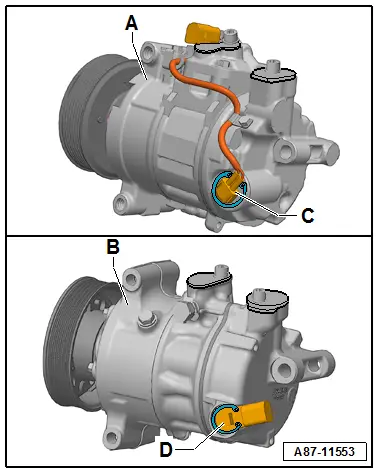
- The A/C Compressor Regulator Valve -N280- is available in different versions and settings. Refer to the Parts Catalog. On an A/C Compressor with an A/C Clutch -N25- (shown is an A/C compressor manufactured by "Denso"), the connector for the vehicle wiring harness connection is mounted directly on the A/C Compressor Regulator Valve -N280--A-. On another A/C compressor, the connector for the vehicle wiring harness connection is combined in a 3-pin connector -E- for the A/C Clutch -N25- and the A/C Compressor Regulator Valve -N280-.
- For version -B- of the A/C Compressor Regulator Valve -N280-, the wire connection may be directly connected to the A/C Compressor Regulator Valve -N280-, or there is an additional connector on the A/C Compressor Regulator Valve -N280-.
- Removing and installing the A/C Compressor Regulator Valve -N280--A and B- is essentially the same on both versions. It only deviates slightly from the procedure described below. On an A/C compressor with a 3-pin connector -E-, disconnect the respective wires to the A/C Compressor Regulator Valve -N280- from the A/C Compressor Regulator Valve -N280-, remove from the connector -E- or cut at a suitable location (and reattach using wire connectors from the Wiring Harness Repair Set -VAS1978B-).
- If the A/C Compressor Regulator Valve -N280- malfunction was found to be caused by dirt, shavings or abraded A/C compressor material after the removal of the A/C Compressor Regulator Valve -N280-, clean the refrigerant circuit and replace the A/C compressor. Refer to → Chapter "Compressor, Replacing on Account of Leakage or Internal Damage" and → Chapter "Refrigerant Circuit, Cleaning (Flushing), with Refrigerant R134a".
Removing
- Discharge the refrigerant circuit. Refer to → Chapter "Using Service Station".
 Caution
Caution
There is a risk of damaging the A/C compressor if the refrigerant circuit is empty.
Do not start the motor if the refrigerant circuit is empty.
- Depending on the version of the A/C Service Station, the pressure of the refrigerant circuit may be less than 1 bar (14.5 psi) absolute pressure after it has been discharged.
- Depending on the version of the A/C compressor, it may be damaged if the pressure in the refrigerant circuit is too low.
- Do not start the engine while the refrigerant circuit pressure is less than the ambient pressure.
- Depending on the vehicle and installed location of the A/C compressor, remove the components that prevent access to the A/C Compressor Regulator Valve -N280-. Refer to → Heating, Ventilation and Air Conditioning; Rep. Gr.87; System Overview - Refrigerant Circuit (vehicle-specific repair manual).
On vehicles where at least one of the two refrigerant lines and the A/C Compressor Regulator Valve -N280- cannot be disconnected and removed while the A/C compressor is attached to the engine.
- Remove the A/C compressor. Refer to → Heating, Ventilation and Air Conditioning; Rep. Gr.87; A/C Compressor (vehicle-specific repair manual).
 Note
Note
A refrigerant line must be removed on an installed A/C compressor so that it is assured, that the pressure in the A/C compressor is the same as the ambient pressure.
On a vehicle, where at least one of the two refrigerant lines and the A/C Compressor Regulator Valve -N280- can be disconnected and removed while the A/C compressor is attached to the engine (the A/C compressor is not removed).
 WARNING
WARNING
There is a danger of ice-up.
- Before removing the A/C Compressor Regulator Valve -N280-, connect the service station and extract the refrigerant. Refrigerant circuit must be empty to avoid possible injury.
- Refrigerant and refrigerant oil will leak out if the refrigerant circuit is not discharged.
- The refrigerant is extracted before removing the A/C Compressor Regulator Valve -N280-. If the A/C Compressor Regulator Valve -N280- is not removed within 10 minutes after extraction, pressure may build up in the refrigerant circuit by renewed evaporation. Extract the refrigerant once more.
- Check the pressure in the refrigerant circuit once more via the A/C service station pressure gauge.
- If the displayed pressure is larger than the ambient pressure (larger than approximately 1 bar (14.5 psi) absolute pressure), turn on the A/C service station and extract the refrigerant that is building up the pressure.
- Disconnect one of the two refrigerant lines from the A/C compressor. Refer to → Heating, Ventilation and Air Conditioning; Rep. Gr.87; System Overview - Refrigerant Circuit (vehicle-specific repair manual).
 Note
Note
A refrigerant line must be removed on an installed A/C compressor so that it is assured, that the pressure in the A/C compressor is the same as the ambient pressure.
All vehicles
- Before removing the A/C Compressor Regulator Valve -N280- check again if the A/C compressor is actually being driven by the belt pulley/drive unit. If the belt pulley or the drive unit overload protection has triggered, the cause for the fault is not the regulator valve but rather the A/C compressor (for example does not move easily).
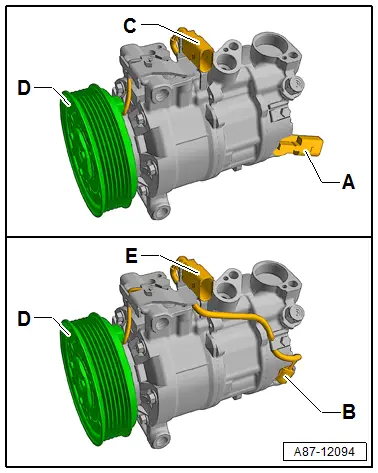
 Note
Note
- This illustration shows the A/C Compressor Regulator Valve -N280--B- on a A/C compressor manufactured by "Sanden" type "PXE 14". On these A/C compressors the connector to the vehicle wiring harness connection is mounted directly on the A/C Compressor Regulator Valve -N280--B-. The removal and installation of the A/C Compressor Regulator Valve -N280--B- on other A/C compressors (other type and manufacturer, for example "Denso", the A/C Compressor Regulator Valve -N280- with a short wiring harness, for example) can differ. The procedure for removal and installation is however the same, as described in the following for the A/C compressor manufactured by "Sanden" type "PXE 14".
- This illustration shows an A/C Compressor Regulator Valve -N280--B- with an O-ring -E- (not available on all versions).
- On a A/C Compressor Regulator Valve -N280--B- without an O-ring -E-, dirt can penetrate into the A/C Compressor Regulator Valve -N280--C- mount up to the O-ring -F-.
- If applicable, loosen the wire connection from the A/C Compressor Regulator Valve -N280--B- to the connection to the vehicle wire harness from the A/C compressor.
 Note
Note
- On an A/C compressor with an A/C Clutch -N25- where the A/C Clutch -N25- is activated via the same connector as the A/C Compressor Regulator Valve -N280--B-, remove the applicable wires from the connector (for example, using an extractor from the Wiring Harness Repair Set -VAS1978B-). Refer to → Heating, Ventilation and Air Conditioning; Rep. Gr.87; System Overview - Refrigerant Circuit (vehicle-specific repair manual).
- If a connector should be installed on an A/C compressor with an A/C Clutch -N25- where the wires cannot be removed, cut the wires to the A/C Compressor Regulator Valve -N280- (or to the A/C Clutch -N25-) at a suitable location and reattach using wire connectors from the Wiring Harness Repair Set -VAS1978B- (or replace the connector itself. Refer to the Parts Catalog). Refer to → Electrical Equipment; Rep. Gr.97; Connectors; Wiring Harnesses and Connectors, Repairing.
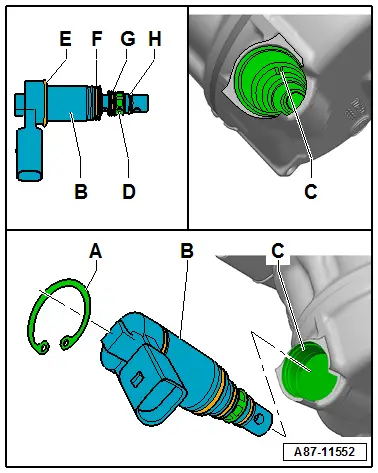
- Clean the A/C compressor near the circlip -A- and the A/C Compressor Regulator Valve -N280--B- thoroughly.
 Caution
Caution
The pressure in the A/C compressor must be equal to the ambient pressure.
- Refrigerant and refrigerant oil can leak out if there is excess pressure in the A/C compressor.
- Dirt can be absorbed into the A/C compressor if there is a vacuum in the A/C compressor.
- Make sure there is pressure equalization before removing the A/C Compressor Regulator Valve -N280--B-.
- Remove the circlip -A-.
- Carefully remove the A/C Compressor Regulator Valve -N280--B- from the A/C compressor mount -C-, using a suitable screwdriver -D-, for example.
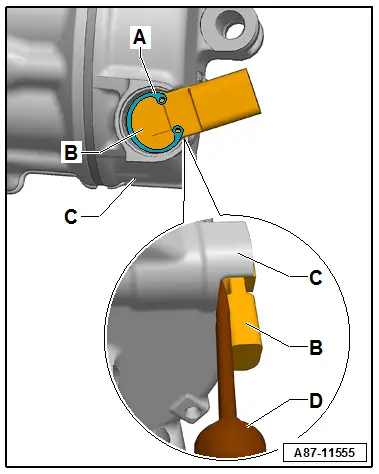
- Check the removed A/C Compressor Regulator Valve -N280--B- and A/C compressor mount -C- for dirt.
 Note
Note
- If the strainer -D-, A/C Compressor Regulator Valve -N280--B- up to the O-ring -F- or the A/C compressor mount -C- are heavily contaminated in this area (with shavings or dark, sticky abraded material, for example), this indicates damage on the A/C compressor. In this case, the refrigerant circuit is to be cleaned and the A/C compressor is to be replaced. Refer to → Chapter "Compressor, Replacing on Account of Leakage or Internal Damage" and → Chapter "Refrigerant Circuit, Cleaning (Flushing), with Refrigerant R134a".
- If the strainer -D- on the A/C Compressor Regulator Valve -N280--B- and the A/C compressor mount -C- up to the O-ring sealing surface -F- are only lightly contaminated in this area (with gray deposits from normal A/C compressor operation, for example), a malfunction at the A/C Compressor Regulator Valve -N280--B- can cause the A/C compressor malfunctioning.
- On an A/C Compressor Regulator Valve -N280--B- without an O-ring -E-, dirt can penetrate into the mount -C- up to the O-ring -E- during operation. Remove the dirt carefully and completely using, for example, a lint-free cloth (do not work with compressed air).
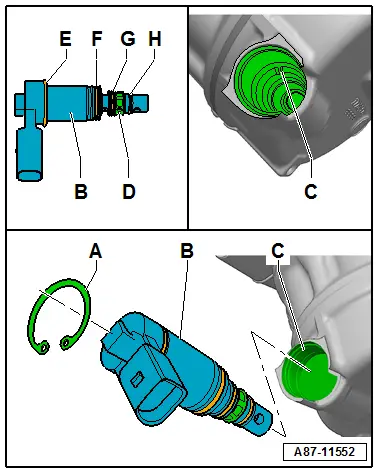
Installing
- Check the A/C compressor mount -C- and the circlip groove for dirt, and if necessary, clean them carefully and thoroughly with a clean, lint-free cloth.
 Caution
Caution
Danger of another A/C Compressor Regulator Valve -N280--B- or A/C compressor failure due to dirt in the A/C compressor or damage to the sealing surfaces in the mount.
- If necessary, carefully clean the A/C compressor mount -C- using only a clean, lint-free cloth (do not use compressed air).
- Make sure while cleaning the mount -C- that no dirt gets into the area underneath the O-ring sealing surface -F- or the existing channels and none of the mount sealing surfaces become damaged.
- Check the A/C compressor mount -C- for damage (also pay attention to small scratches on the surface, if there is damage, replace the A/C compressor).
- Check the O-rings -F,G and H- and -E- (if applicable) of the A/C Compressor Regulator Valve -N280--B- for damage.
- Coat the O-rings -F, G and H- and -E- (if applicable) of the A/C Compressor Regulator Valve -N280--B- lightly with refrigerant oil and check for proper seating.
- Insert the A/C Compressor Regulator Valve -N280--B- until the stop in the A/C compressor mount -C-.
- Install the new circlip -A- and check for proper seating in the groove.
- Install the removed parts in the opposite order.
- Evacuate and refill the refrigerant circuit. Refer to → Chapter "Using Service Station".
 Note
Note
Should refrigerant oil escape with the A/C Compressor Regulator Valve -N280--B- removed, add this amount of refrigerant oil while filling the refrigerant oil with the A/C service station. Refer to → Chapter "Using Service Station".
- Check the A/C function. Refer to → Chapter "Pressures, Checking" and → Heating, Ventilation and Air Conditioning; Rep. Gr.87; System Overview - Refrigerant Circuit (vehicle-specific repair manual).

